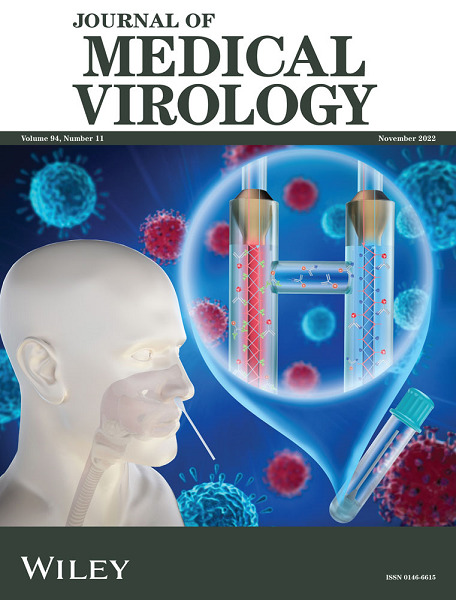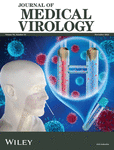Journal list menu
Export Citations
Download PDFs
COVER
Cover Image, Volume 94, Number 11, November 2022
- Page: i
- First Published: 13 September 2022

Front Cover Caption: The cover image is based on the Research Article Rapid and universal detection of SARS-CoV-2 and influenza A virus using a reusable dual-channel optic fiber immunosensor by Yi Yang et al., https://doi.org/10.1002/jmv.28015.
ISSUE INFORMATION
COMMENTARY
Ending the COVID-19 pandemic: We still have a long way to go
- Pages: 5075-5076
- First Published: 07 July 2022
LETTERS TO THE EDITOR
The emergence of Omicron lineages BA.4 and BA.5, and the global spreading trend
- Pages: 5077-5079
- First Published: 30 June 2022
Myopericarditis in young subjects after vaccination, clearing the clouds of misunderstanding
- Pages: 5080-5081
- First Published: 07 July 2022
The complex evolutionary dynamics of SARS-CoV-2, a big challenge to control the pandemic of COVID-19
- Pages: 5082-5085
- First Published: 07 July 2022
In response to: Olfactory dysfunction in COVID-19, new insights from a cohort of 353 patients: The ANOSVID study
- Pages: 5086-5087
- First Published: 13 July 2022
Severe acute pediatric hepatitis: The undue emphasis on adenovirus needs to be reassessed
- Pages: 5088-5089
- First Published: 20 July 2022
Neutralization of distinct Omicron sublineages by longitudinal vaccination sera
- Pages: 5090-5092
- First Published: 22 July 2022
Measles in Pakistan: Consideration of vaccine for children below 9 months
- Pages: 5093-5095
- First Published: 22 July 2022
REVIEWS
The Deltacron conundrum: Its origin and potential health risks
- Pages: 5096-5102
- First Published: 11 July 2022
SARS-CoV-2 infection and lytic reactivation of herpesviruses: A potential threat in the postpandemic era?
- Pages: 5103-5111
- First Published: 12 July 2022
The global impact of COVID-19 pandemic on the incidence of pediatric new-onset type 1 diabetes and ketoacidosis: A systematic review and meta-analysis
- Pages: 5112-5127
- First Published: 13 July 2022
The deciphering of the immune cells and marker signature in COVID-19 pathogenesis: An update
- Pages: 5128-5148
- First Published: 14 July 2022
Association of histo-blood group antigens and predisposition to gastrointestinal diseases
- Pages: 5149-5162
- First Published: 26 July 2022
Interplay between cellular metabolism and DNA viruses
- Pages: 5163-5173
- First Published: 22 July 2022
RESEARCH ARTICLES
SARS-CoV-2 ORF10 antagonizes STING-dependent interferon activation and autophagy
- Pages: 5174-5188
- First Published: 28 June 2022
Temporal changes in the accessory protein mutations of SARS-CoV-2 variants and their predicted structural and functional effects
- Pages: 5189-5200
- First Published: 28 June 2022
Investigation of the effect of COVID-19 on sperm count, motility, and morphology
- Pages: 5201-5205
- First Published: 01 July 2022
Immunoassay and mass cytometry revealed immunological profiles induced by inactivated BBIBP COVID-19 vaccine
- Pages: 5206-5216
- First Published: 08 July 2022
Concordance of B- and T-cell responses to SARS-CoV-2 infection, irrespective of symptoms suggestive of COVID-19
- Pages: 5217-5224
- First Published: 21 July 2022
Analysis of ACE2 and TMPRSS2 coding variants as a risk factor for SARS-CoV-2 from 946 whole-exome sequencing data in the Turkish population
- Pages: 5225-5243
- First Published: 10 July 2022
COVID-19 vaccine breakthrough infection among fully vaccinated healthcare workers in Duhok governorate, Iraqi Kurdistan: A retrospective cohort study
- Pages: 5244-5250
- First Published: 10 July 2022
The variant-specific burden of SARS-CoV-2 in Michigan: March 2020 through November 2021
- Pages: 5251-5259
- First Published: 07 July 2022
Relevant SARS-CoV-2 viremia is associated with COVID-19 severity: Prospective cohort study and validation cohort
- Pages: 5260-5270
- First Published: 10 July 2022
Evaluation of SARS-CoV-2 viral load kinetics in plasma assessed by quantitative RT-PCR as an indicator of poor prognosis in hospitalized COVID-19 patients.
Change in willingness to COVID-19 vaccination in China: Two online surveys during the pandemic
- Pages: 5271-5278
- First Published: 18 July 2022
Clinical characteristics and outcomes of healthcare workers with COVID-19 pre- and postvaccination
- Pages: 5279-5283
- First Published: 13 July 2022
Comparison of the respiratory tract microbiome in hospitalized COVID-19 patients with different disease severity
- Pages: 5284-5293
- First Published: 15 July 2022
Differential avidity determination of IgG directed towards the receptor-binding domain (RBD) of SARS-CoV-2 wild-type and its variants in one assay: Rational tool for the assessment of protective immunity
- Pages: 5294-5303
- First Published: 18 July 2022
Single-cell transcriptomic atlas reveals distinct immunological responses between COVID-19 vaccine and natural SARS-CoV-2 infection
- Pages: 5304-5324
- First Published: 20 July 2022
Rapid and universal detection of SARS-CoV-2 and influenza A virus using a reusable dual-channel optic fiber immunosensor
- Pages: 5325-5335
- First Published: 20 July 2022
Early predictors of clinical deterioration in a cohort of outpatients with COVID-19 in southern Italy: A multicenter observational study
- Pages: 5336-5344
- First Published: 19 July 2022
Association between COVID-19 and telomere length: A bidirectional Mendelian randomization study
- Pages: 5345-5353
- First Published: 19 July 2022
Spatiotemporal analysis of the morbidity of global Omicron from November 2021 to February 2022
- Pages: 5354-5362
- First Published: 21 July 2022
The mutation features and geographical distributions of the surface glycoprotein (S gene) in SARS-CoV-2 strains: A comparative analysis of the early and current strains
- Pages: 5363-5374
- First Published: 24 July 2022
High levels of C-reactive protein-to-albumin ratio (CAR) are associated with a poor prognosis in patients with severe fever with thrombocytopenia syndrome in early stage
- Pages: 5375-5384
- First Published: 05 July 2022
A seroepidemiological study across age groups before and after the 2010–2011 mumps epidemic in Japan
- Pages: 5385-5391
- First Published: 07 July 2022
Development and characterization of an inducible assay system to measure Zika virus capsid interactions
- Pages: 5392-5400
- First Published: 12 July 2022
Epidemiology and genetic characterization of human metapneumovirus in pediatric patients from Hangzhou China
- Pages: 5401-5408
- First Published: 24 July 2022
Prevalence of anti-parvovirus B19 IgG and IgM and parvovirus B19 viremia in pregnant women in an urban area of Northern Italy
- Pages: 5409-5414
- First Published: 28 June 2022
Rock1 is a novel host dependency factor of human enterovirus A71: Implication as a drug target
- Pages: 5415-5424
- First Published: 05 July 2022
Effects of baloxavir and oseltamivir antiviral therapy on the transmission of seasonal influenza in China: A mathematical modeling analysis
- Pages: 5425-5433
- First Published: 30 June 2022
Cell-to-cell transmission of HIV-1 from provirus-activated cells to resting naïve and memory human primary CD4 T cells is highly efficient and requires CD4 and F-actin but not chemokine receptors
- Pages: 5434-5450
- First Published: 15 July 2022
HIV-1 eradication from infected individuals remains a major medical challenge. Combination antiretroviral therapy (ART) has led to a profound reduction in HIV-1-related morbidity and mortality. However, ART fails to eliminate HIV-1, as patients on ART still have residual viremia. The persistent viremia mainly arises from replication-competent proviruses in long-lived latently infected cells, which represent a major obstacle for HIV-1 eradication. One major effort to purge these latently infected cells has focused on developing the “shock and kill” approach for forcing provirus reactivation to induce cell killing. The “shock and kill” approach must be used with ART to prevent new infections. We studied the kinetic and mechanistic events of HIV-1 protein expression, virion production, and virus transmission and blockade during provirus reactivation. Our results suggest that ART regimens in clinical application of the “shock and kill” approach should contain PIs plus RT inhibitors to simultaneously prevent and inhibit new infection from provirus-activated cells.
Factors associated with high alanine aminotransferase (ALT) and cirrhosis in people living with HIV on combination antiretroviral treatment (cART) in the Asia-Pacific
- Pages: 5451-5464
- First Published: 22 July 2022
Real-life impact of tenofovir disoproxil fumarate and entecavir therapy on lipid profile, glucose, and uric acid in chronic hepatitis B patients
- Pages: 5465-5474
- First Published: 06 July 2022
Pegylated interferon-α-2b combined with tenofovir disoproxil fumarate, granulocyte-macrophage colony-stimulating factor, and hepatitis B vaccine treatment for naïve HBeAg-positive chronic hepatitis B patients: A prospective, multicenter, randomized controlled study
- Pages: 5475-5483
- First Published: 14 July 2022
Relationship of herpesvirus (HSV1, EBV, CMV, HHV6) seropositivity with depressive disorder and its clinical aspects: The first study in children
- Pages: 5484-5491
- First Published: 12 July 2022
MORC3 restricts human cytomegalovirus infection by suppressing the major immediate-early promoter activity
- Pages: 5492-5506
- First Published: 25 July 2022
Simian virus 40 DNA in immunocompetent children with respiratory disease
- Pages: 5507-5511
- First Published: 05 July 2022
Longitudinal follow-up of HPV16 sequence after cervical infection: Low intrahost variation and no correlation with clinical evolution
- Pages: 5512-5518
- First Published: 07 July 2022
Prevotella as the hub of the cervicovaginal microbiota affects the occurrence of persistent human papillomavirus infection and cervical lesions in women of childbearing age via host NF-κB/C-myc
- Pages: 5519-5534
- First Published: 14 July 2022
Decline in human T-cell lymphotropic virus seroprevalence in blood donors from Minas Gerais, Brazil over a 12-year period (2006–2017)
- Pages: 5535-5542
- First Published: 19 July 2022
SHORT COMMUNICATIONS
Viral load of SARS-CoV-2 Omicron is not high despite its high infectivity
- Pages: 5543-5546
- First Published: 05 July 2022
Rhinovirus persistence during the COVID-19 pandemic—Impact on pediatric acute wheezing presentations
- Pages: 5547-5552
- First Published: 10 July 2022
Safety and immunogenicity of COVID-19 vaccination in patients with hepatocellular carcinoma (CHESS-NMCID 2101): A multicenter prospective study
- Pages: 5553-5559
- First Published: 10 July 2022
Clinical presentations of adult and pediatric SARS-CoV-2-positive cases in a community cohort, Nashville, Tennessee
- Pages: 5560-5566
- First Published: 11 July 2022
Dynamics of nasopharyngeal tract phageome and association with disease severity and age of patients during three waves of COVID-19
- Pages: 5567-5573
- First Published: 13 July 2022
A soluble DR5-Fc chimeric protein attenuates inflammatory responses induced by coronavirus MHV-A59 and SARS-CoV-2
- Pages: 5574-5581
- First Published: 22 July 2022
Safety and efficacy of molnupiravir in SARS-CoV-2-infected patients: A real-life experience
- Pages: 5582-5588
- First Published: 20 July 2022
Reinfection with SARS-CoV-2 in general population, South Korea; nationwide retrospective cohort study
- Pages: 5589-5592
- First Published: 25 July 2022
Full genome analysis of circulating DENV-2 in Senegal reveals a regional diversification into separate clades
- Pages: 5593-5600
- First Published: 25 July 2022





